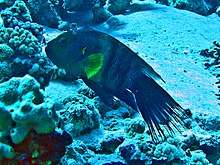Broomtail wrasse
The broomtail wrasse (Cheilinus lunulatus) is a species of wrasse native to the Red Sea and Indian Ocean.
| Broomtail wrasse | |
|---|---|
| Male, Dahab, Egypt | |
 | |
| Female, Sharm el Sheik, Egypt | |
| Scientific classification | |
| Kingdom: | Animalia |
| Phylum: | Chordata |
| Class: | Actinopterygii |
| Order: | Labriformes |
| Family: | Labridae |
| Genus: | Cheilinus |
| Species: | C. lunulatus |
| Binomial name | |
| Cheilinus lunulatus (Forsskål, 1775) | |
| Synonyms[2] | |
| |
Description
Cheilinus lunulatus can reach an average length of about 35 cm (14 in), with a maximum of 50 cm (20 in) in males. In adults, the head is large and bright green, with small spots. The lips are large and blue. The pectoral fins are yellow, while the abdominal, the anal, and caudal fins are dark blue. The body is yellow-green in the middle and dark purple in the other part. Close to the operculum is a characteristic bright-yellow marking on a black background. It has a long fringed caudal fin, resembling an old broom (hence the common name). Females and juveniles show large, dark stripes on their flanks. This wrasse feeds mainly on molluscs and hard-shelled invertebrates. It is oviparous.
Distribution
This species occurs in the Red Sea to the Gulf of Oman (mainly near Djibouti, Eritrea, the Seychelles, and Somalia). In the Indo-Pacific, it is replaced by the closely related Cheilinus trilobatus.
Habitat
Broomtail wrasses can be found on coral reefs and on adjacent sand and seagrass habitats, at depths of from 2 to 30 m (6.6 to 98.4 ft).
References
- Choat, J.H. (2010). "Cheilinus lunulatus". IUCN Red List of Threatened Species. 2010: e.T187618A8582092. doi:10.2305/IUCN.UK.2010-4.RLTS.T187618A8582092.en. Retrieved 29 December 2019.
- Froese, Rainer and Pauly, Daniel, eds. (2019). "Cheilinus lunulatus" in FishBase. August 2019 version.
- FishBase
- World Register of Marine Species link: Cheilinus lunulatus (+species list)
- Biolib
- Pictures of C. lunulatus
- Fran.cornu.free
- Lieske E., 1998 - Peces de arrecifes coralinos del Indo-Pacífico y Caribe – Omega, Barcelona
- Randall J.E. - Red Sea reef fishes - Immel Publishing, London 1986
External links
- Photos of Broomtail wrasse on Sealife Collection
